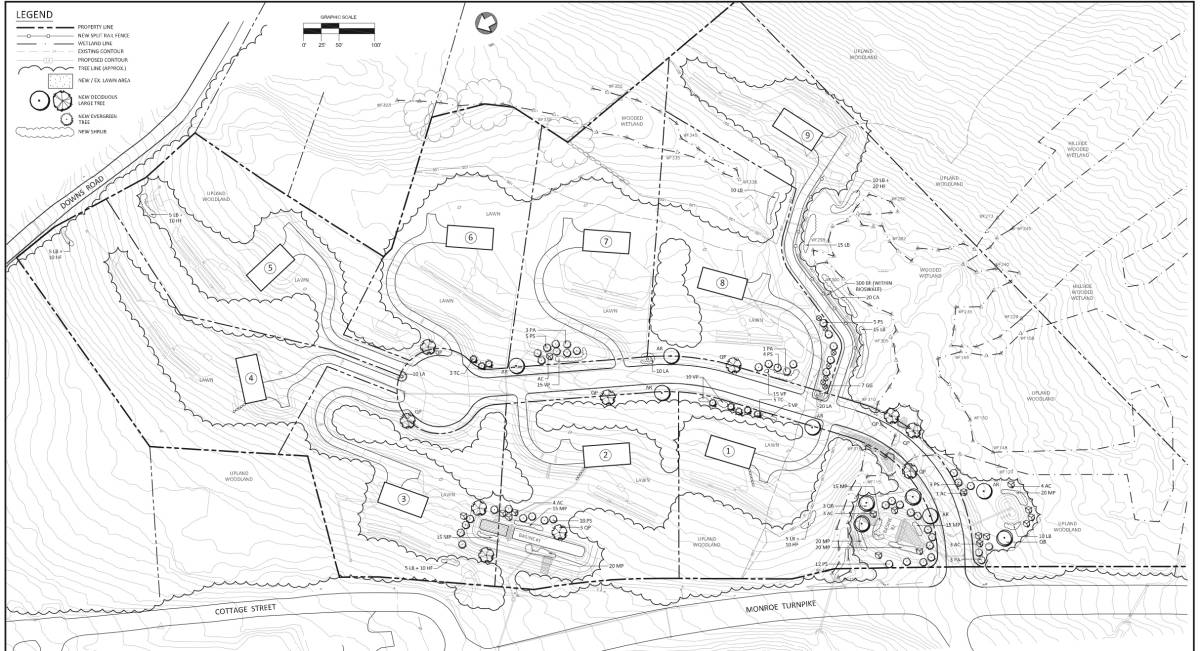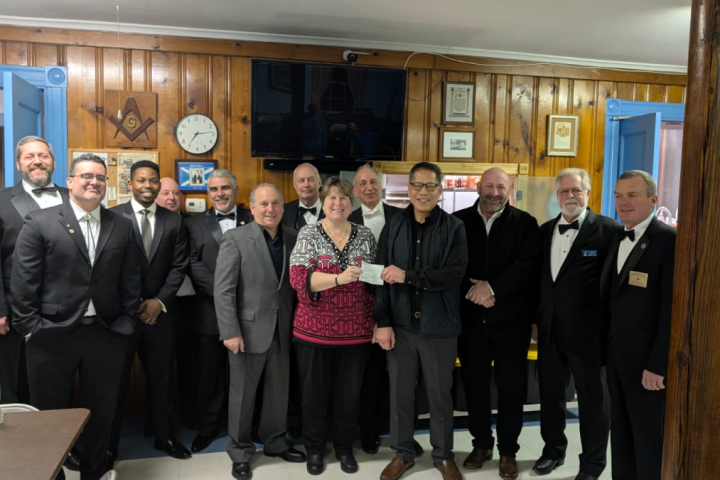MONROE, CT — Inland Wetlands Commission members approved the application for Sun Valley Glen Estates with conditions Wednesday night. Neighboring property owners strongly oppose the controversial proposal to build eight homes in a cluster development at 1536 and 1564 Monroe Turnpike, across from the former Stevenson Lumber property.
The plan, which now needs Planning and Zoning Commission approval for the subdivision and site plan, allows for homes to be built on smaller 1.5 acre lots, while preserving 30 percent, rather than 15 percent, of the 34-acre site as open space.
Neighbors expressed several concerns during the hearing, particularly over erosion, drainage and the disturbance of wetlands and wildlife habitats.
During deliberations, Andrew Brodtman, the town’s inland wetlands officer, said he does not want to lose the woodland.
“In my opinion, I have a fundamental problem with turning this into a development,” he said. “But I have a hard time telling the applicant he can’t develop it. I can’t see a legal reason to deny it.”
After talking about the proposed box culvert design and the location of the entrance to the site, the commission approved the wetlands application, as well as a positive subdivision referral to the Planning and Zoning Commission, by two votes of 4-2-1.
In a voice vote for the wetlands approval, commissioners Paul Fernandes, Jim Stewart, Chairman Erik Lindstrom and Vice Chairman Ryan Kelly voted yes, Benjamin Sabia voted no, Rick Smith voted “hell no” and Mark Zamary decided to abstain because he is a new board member and was not as familiar with the application.
The vote on the referral went the same way.
Commissioners were concerned over the location of the driveway, across from Old Zoar Road, because it requires the new road to cross over a portion of the wetlands.
Representatives for the applicant, Jans Land Development LLC, told them a Connecticut Department of Transportation requirement on the spacing of intersections left them no choice but to place the driveway there.
During deliberations, Smith pointed out that Dr. Michael Klemons, the environmental consultant hired by the commission, requested a more definitive and specific ruling from the DOT about the location.
Smith said Jason Edwards, the engineer for the applicant, showed an email from someone through CT.Gov restating that a minimum distance of 400 feet between intersections is “suggested” for intersection spacing.
Smith said the DOT manual says “in general all intersections should preferably be 400 feet apart.”
But the commissioner expressed his belief that the loose language allows for exceptions.
Smith said the proposed road, along with the retention ponds and removal of trees is “simply too much disturbance.” “It’s a wide swath through the wetlands,” he said.
Kelly said he believes the applicant’s experts did all they could to reduce the impact on the wetlands, in addition to proposing a conservation easement and expanding the open space area.
“I don’t believe that to be accurate,” he said of the impact on the wetlands Smith spoke of. “The heart of the wetlands, I believe that’s in the fingers, which are protected.”
Kelly said he favors the second alternative the applicant proposed for the driveway, which is a little further down the hill.
“Though there is a steeper slope there, I think it’s the best area to protect the wetlands crossing,” he said. “I think being further away from those fingers in the easement is better.”
“I agree. The second position is narrower,” Lindstrom said. “It didn’t look like there is as much life in that space. It’s more challenging for them to put it in there, but the impact on the wetlands is less.”
Lindstrom noted how the commission asked the applicant several times about an alternative location for the driveway to avoid crossing the wetlands. He seemed satisfied with Edwards’ explanation that the DOT prefers the location in the proposal.
If the commission were to deny the application, Stewart said the town would need evidence from an expert that the wetlands disturbance would cause a quantifiable amount of damage to win a legal appeal.
Town Engineer James DiMeo said he believes the commission could call Klemons back for questioning. However, the commission ultimately decided against it, because that would be limited to Klemons’ report since the hearing is closed and no new evidence could be accepted into the record.
“I have a few concerns myself,” Sabia said of the location of the driveway. “I’m more concerned about introducing the human element to that area. As a road, people could throw trash out the window and into that stream that hadn’t seen garbage.”
Sabia said trucks would spread salt in the wintertime, adding the human activity “could completely change the ecosystem of that waterway.”
“That’s my biggest thing, bringing that human element into a place that really shouldn’t have a human element coming through it,” he said.
“My understanding is people have a right to cross wetlands to build,” Stewart said. “It’s whether they are doing it responsibly.”
If the commission were to deny the application over the driveway, Kathleen Gallagher, the town’s planning and zoning administrator, said there needs to be a prudent and reasonable alternative.
Throughout the hearing, Brodtman said the applicant addressed all the concerns the commission and town staff raised.
Commissioners also debated the choice of a four-sided box culvert over a three-sided one — which Klemons had favored — and Smith said there could possibly be a better design.
Smith suggested a concrete span used in building bridges as an alternative to a culvert, but with the hearing closed, Lindstrom said the commission cannot say, “now we want a bridge.”
Smith also called for a traffic study for potential driveway locations, but Lindstrom said traffic is not within the Inland Wetlands Commission’s purview.
If the commission decided not to vote Wednesday night, Brodtman said they would have had to decide on the application at their next meeting due to the state statutory deadline of taking action within 65 days.
The commission’s approval includes a performance bond of $85,770. Among the conditions:
- The applicant shall use existing stone meeting the proposed dimensional requirements in the top layer, to the extent possible, for the four-sided culvert crossing.
- There shall be conservation markers every 50 feet in conservation areas, and additional wetland markers in lots one, seven and eight as approved by the inland wetlands officer.
- The conservation easement language shall add the Inland Wetlands Commission as one of the authoritative bodies.
- The applicant must respond to some outstanding comments in the town engineer’s last memo submitted on Oct. 9.
All respectful comments with the commenter’s first and last name.







Was it approved as eight homes or nine? The drawing with this article shows nine.
I must have used an older drawing. It’s eight, they removed one early on.
They removed lot 9, and the road, not a driveway, has been moved farther down to disturb 1,100 sf rather than 3,800 sf.
Did the area where the new road goes thru the wetlands get flooded during the August storm? We should avoid adding roads that need repairs after heavy storms.